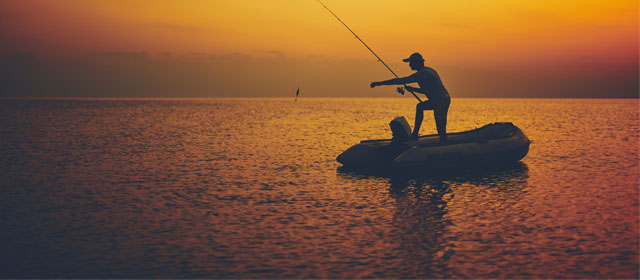Best Times to Fish
Since weather, tide, and other conditions affect species behavior, knowing the best times to fish is essential.
Fish Finders and Water Temperature Gauges
Too many hot days can make fish in shallow lakes, ponds, and rivers sluggish. The same thing happens in the winter when water temperatures are lower. Why? All fish are cold-blooded, meaning they can't keep their body temperature at a constant level. So the temperature of their surroundings influences the fish's body temperature and bodily functions.
Really high and really low water temperatures reduce the amount of oxygen in the water, making fish less active and picky about when and what they eat. When it comes to finding the best fishing times, a good starting point is to avoid extreme temperatures.
For more accurate analysis of the water to find out when the fish are biting, fish finders and water temperature gauges can give anglers up-to-the-minute feedback on temperature.
Daily Fishing Forecast
Other factors like bright sunlight can also affect fish activity so it’s important to pay attention to the time of day you plan to go, which can make all the difference in your success. Fish generally prefer early morning and evening sun to the bright midday rays. In midday, the surface temperature of the water is also hotter, forcing the fish to move deeper.
Tools like a daily fishing forecast – available online through resources like Farmers’ Almanac -- can help you learn if fish will be biting on a particular day and, if so, the best fishing times.
Fishing Calendar

Variable weather conditions can be a big factor in determining the best times to fish. Wind can play a large role in because it pushes water and surface food to the far shore. Storms also affect fishing success, increasing feeding during the hours immediately before a cold front but slowing during and after a storm or front hits. The exception is a warm front, which causes surface water temperatures to increase, putting fish into a feeding frenzy.
Another good opportunity to fish is on cloudy days since overcast skies cause fish to cruise for food more than on bright days. Light rain is also one of the best fishing times, especially because it washes insects and bait into the water, creating a feeding binge for fish.
For more exact targeting of the best times to fish, you may want to try a fishing calendar. These tools use data from your exact location like the weather patterns as well as other considerations such as tide, and moon phases combined with feeding behavior to determine when it’s ideal to fish for the species you want to catch.
With many fishing calendar apps available, these handy resources allow you to anticipate increased fish activity so you can plan your outing well in advance – or even identify a better location to try.
Ask Around
Finally, don’t be afraid to ask your local fellow anglers. Local regulars can often provide a wealth of useful information. Not only will most share their most successful times, you’ll often find at least one local around who knows where to get the info you’re looking for broken down by season and specific types of fish. So head over to the local bait shop or wherever you get your fishing supplies and strike up a friendly conversation. If you fish in public facilities, stop by the info shack if there is one available.
Now that you know the best fishing times during different seasons, check out Farmers’ Almanac Best Days To Fish Calendar and consult your local daily fishing forecast for current conditions. Don't forget to purchase your fishing license online and get ready for the fun!
KEEP LEARNING

How to Tie the Non-Slip Loop Knot
The non-slip loop knot is a popular and reliable choice for securing hooks, lures, and other tackle to your fishing line.
LEARN MORE

Socials
Take me fishing social media links
LEARN MORE

TakeMeFishing x Teen Vogue
Join us on a creative journey as fashion designer Ahmrii Johnson walks us through her collaborative vision and process with Teen Vogue and fashion brand, Rentrayage, to create a special piece.
LEARN MORE


.png?lang=en-US&ext=.png)